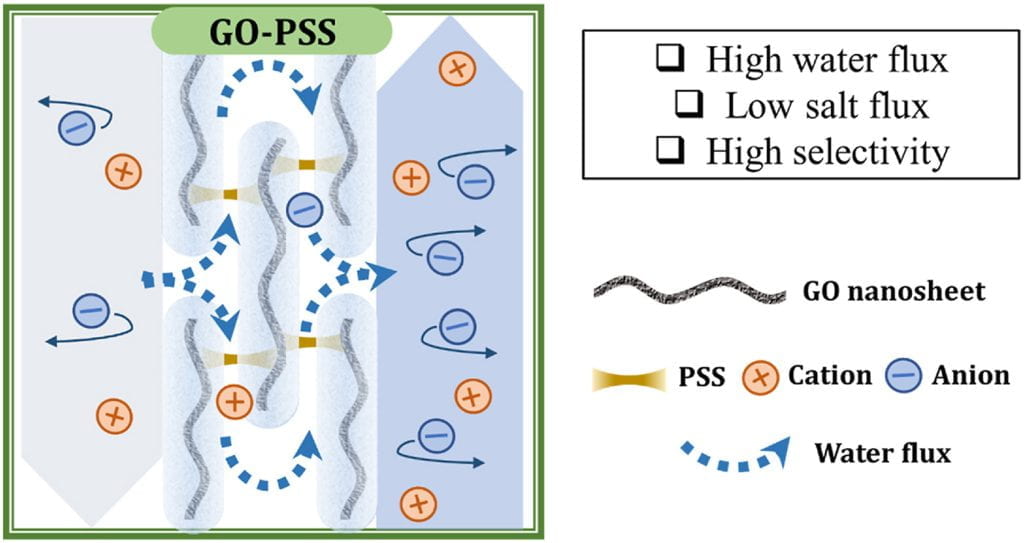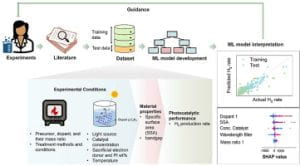
Zhong, M., Li, X., Chu, X., Gui, H., Zuo, S., Yao, C., Li, Z., & Chen, Y. (2022). Solar driven catalytic conversion of cellulose biomass into lactic acid over copper reconstructed natural mineral. Applied Catalysis B: Environmental, 317, 121718.
This research introduces a solar-driven catalysis system to convert biomass-based cellulose into lactic acid using a copper-modified natural palygorskite catalyst. When copper is added beyond 6 wt%, it enhances the catalyst’s efficiency, promoting better charge transfer and aiding in the conversion of intermediates. This copper-enhanced catalyst shows impressive photocatalytic lactic acid production under visible light. Using both experimental techniques and theoretical calculations, the study identifies the specific reactions that lead to lactic acid formation from cellulose. This innovative approach offers a sustainable method for transforming biomass into valuable products. Learn more

Tong, X., Liu, S., Zhao, Y., Xiao, C., Chen, Y., & Crittenden, J. (2022). A freestanding graphene oxide framework membrane for forward osmosis: Separation performance and transport mechanistic insights. Journal of Membrane Science, 661, 120919.
The study delves into the potential of graphene oxide (GO) membranes in forward osmosis (FO). Despite their promise, understanding mass transfer within GO membranes remains incomplete. This research synthesized freestanding GO framework membranes and tested their efficiency in FO systems, focusing on water and salt fluxes. A particularly effective membrane was created using GO nanosheets combined with polyelectrolyte spacers, demonstrating superior water/salt selectivity. The research discovered that membrane pore characteristics impact salt transport. By combining experimental data and numerical modeling, the study further explored how the electrical double layer within the pores affects salt transport, offering insights for optimizing future GO membrane designs. Learn more

Yan, L., Zhong, S., Igou, T., Gao, H., Li, J., & Chen, Y. (2022). Development of machine learning models to enhance element-doped g-C3N4 photocatalyst for hydrogen production through splitting water. International Journal of Hydrogen Energy, 47(80), 34075-34089.
This research employs machine learning (ML) models to optimize the photocatalytic performance of element-doped graphitic carbon nitride (D-g-C3N4) in hydrogen production. Instead of traditional trial-and-error methods, the models predict hydrogen production rates based on various experimental parameters. Testing demonstrates the ML models effectively predict these rates. Sensitivity analysis identifies both widely recognized and lesser-explored parameters affecting performance. The study’s approach offers a more efficient way to design elemental doping strategies for g-C3N4, potentially transforming future catalyst design by eliminating the need for costly, time-intensive experiments. Learn more

Gao, H., & Chen, Y. (2022). Hybrid Dimensional MXene/CNC Framework-Regulated Nanofiltration Membrane with High Separation Performance. ACS ES&T Water.
The study introduces an enhanced Thin Film Composite (TFC) nanofiltration (NF) membrane for water treatment, overcoming traditional limitations in permeability and selectivity. By incorporating a hybrid dimensional MXene/CNC framework as an interlayer, the membrane achieves improved water flow due to the modified surface and polyamide network. This design not only boosts water permeability but also retains high rejection rates for salts and antibiotics. Computational simulations further validated the effectiveness of the MXene/CNC interlayer. The research paves the way for leveraging 2D material frameworks to design more efficient water separation membranes. Learn more

Kim, J., Xin, X., Mamo, B. T., Hawkins, G. L., Li, K., Chen, Y., Huang, Q., & Huang, C. H. (2022). Occurrence and fate of ultrashort-chain and other per-and polyfluoroalkyl substances (PFAS) in wastewater treatment plants. ACS ES&T Water, 2(8), 1380-1390.
The study examined how per- and polyfluoroalkyl substances (PFAS) behave during wastewater treatment in two municipal plants. Through analyzing 42 PFAS varieties, the research found that short-chain PFAS were more prevalent in wastewater, while long-chain variants dominated in sludge. Wastewater treatment processes amplified PFAA concentrations, especially after biological treatment. The study emphasized that biological treatment transforms PFAS precursors into shorter chains and longer chains get trapped in sludge. Given the increasing prominence of short-chain PFAS, the research suggests further investigation into the behavior and distribution of both old and new PFAS in wastewater treatment plants. Learn more

Tong, X., Liu, S., Zhao, Y., Huang, L., Crittenden, J., & Chen, Y. (2022). MXene composite membranes with enhanced ion transport and regulated ion selectivity. Environmental Science & Technology, 56(12), 8964-8974.
MXene composite membranes have been enhanced by adding spacing agents with SO3H groups. This innovation improves ion conductance and selectivity, making it ideal for power generation using salinity gradients and lithium-ion recovery. A notable outcome was achieved using poly(sodium 4-styrenesulfonate) (PSS) as the spacing agent, producing a power density of 1.57 W/m2 and showing notable Li+ selectivity against Na+ and K+. The larger and more charged nanochannels in the membrane aid ion movement, while the binding affinity between Li+ and SO3H is especially strong. This approach offers potential for designing efficient 2D material-based membranes for energy and ion recovery. Learn more

Quan, S. J., Chang, S., Castro-Lacouture, D., Igou, T. K., Dutt, F., Ding, J., Chen, Y., & Pei-Ju Yang, P. (2022). Planning decentralized urban renewable energy systems using algal cultivation for closed-loop and resilient communities. Environment and Planning B: Urban Analytics and City Science, 49(5), 1464-1488.
To combat climate challenges, a decentralized urban renewable energy system using algal biotechnology is proposed to treat waste and produce biomass. This study investigates the energy performance of this system in various urban settings in Atlanta, considering factors like urban density, form, and scale. A GIS model estimates energy yields, revealing the best performance in high-density neighborhoods at small-to-medium scales. The research finds that increasing scale slightly diminishes energy performance, with optimal scales being a 1-km and 1.3 km radius for real and hypothetical cases respectively. Learn more

Zhao, Y., Tong, X., Kim, J., Tong, T., Huang, C. H., & Chen, Y. (2022). Capillary-assisted fabrication of thin-film nanocomposite membranes for improved solute–solute separation. Environmental science & technology, 56(9), 5849-5859.
To effectively separate harmful contaminants like PFASs from valuable components in wastewater, a new technique, capillary-assisted interfacial polymerization (CAIP), has been introduced. This creates metal–organic framework (MOF)-PA nanocomposite membranes with reduced surface charges and uniform pore sizes, enhancing solute selectivity. The CAIP technique optimizes PA–MOF interactions, resulting in better exposure of MOF nanochannels on the membrane surface. This leads to remarkable water permeance and high selectivity between nutrient ions and PFASs, offering a promising approach for wastewater treatment. Learn more

Jiang, S., Xiao, S., Chu, H., Sun, J., Yu, Z., Zhang, W., Chen, Y., Zhou, X., & Zhang, Y. (2022). Performance enhancement and fouling alleviation by controlling transmembrane pressure in a vibration membrane system for algae separation. Journal of Membrane Science, 647, 120252.
Jiang, S., Xiao, S., Chu, H., Sun, J., Yu, Z., Zhang, W., Chen, Y., Zhou, X., & Zhang, Y. (2022). Performance enhancement and fouling alleviation by controlling transmembrane pressure in a vibration membrane system for algae separation. Journal of Membrane Science, 647, 120252.

Huo, C., Hao, Z., Yuan, C., Chen, Y., & Liu, J. (2022). Probing the phytosynthesis mechanism of gold and silver nanoparticles by sequential separation of plant extract and molecular characterization with ultra-high-resolution mass spectrometry. ACS Sustainable Chemistry & Engineering, 10(12), 3829-3838.
The study explores the phytosynthesis of nanoparticles (NPs) using persimmon fruit extract, emphasizing the unclear mechanisms behind plant-based NP creation. Through sequential solvent fractionation, the extract yielded different fractions that, when used to produce gold and silver NPs, resulted in varying morphologies and reaction speeds. Ultra-high-resolution mass spectrometry revealed compositional differences among the fractions. NP formation involved a combination of strong and weak reducing agents, with NP morphology influenced by cyclic and highly unsaturated compounds. Differences were noted between gold and silver NP synthesis. Learn more

Sun, X., Liu, Y., Xu, R., & Chen, Y. (2022). MOF-derived nanoporous carbon incorporated in the cation exchange membrane for gradient power generation. Membranes, 12(3), 322.
The study focuses on enhancing the performance of ion exchange membranes (IEMs) used in reverse electrodialysis (RED) systems for power generation. Metal organic framework-derived nanoporous carbons (HZCs) were integrated into a specific type of membrane, resulting in an organic-inorganic nanocomposite cation exchange membrane. Findings revealed that the optimal HZCs-loaded membrane showed significant improvements in power density and efficiency. Thus, introducing the right amount of HZCs into IEMs offers a promising approach to boost power production in RED systems. Learn more

Meng, S., Tong, Z., Zhang, S., Li, G., Bao, H., Bruner, S. D., Li, Y. C., & Chen, Y. (2022). Biowaste-derived, hyperbranched dendritic EDTA analogue as an anionic biochelator with superior metal affinity. ACS Sustainable Chemistry & Engineering, 10(6), 2010-2021.
The study focuses on creating a dendritic biopolymer ligand from biowaste lignin, aiming to enhance its metal-binding properties. Natural polymers often lack reactivity due to their structures, but by grafting lignosulfonate with specific functional groups, an EDTA analogue with superior chelating abilities was developed. Advanced instruments confirmed its structure and improved metal complexation capability. This biopolymer displayed a stronger affinity for divalent metals compared to traditional ligands. This approach not only promotes a circular bioeconomy but also offers a promising, cost-effective solution for applications requiring metal chelation. Learn more

Zhong, S., Lambeth, D. R., Igou, T. K., & Chen, Y. (2022). Enlarging Applicability Domain of Quantitative Structure–Activity Relationship Models through Uncertainty-Based Active Learning. ACS ES&T Engineering, 2(7), 1211-1220.
This study introduces an uncertainty-based active learning (AC) approach to improve the development of quantitative structure–activity relationship (QSAR) models, which predict chemical properties. The study uses Gaussian processes to develop these models for three datasets and compares results from random splitting and uncertainty-based AC methods. Active learning-selected models outperformed in generalizability and had a broader applicability domain (AD) when predicting properties in the REACH dataset. The findings suggest that the active learning approach enhances the QSAR model’s reliability, efficiency, and scope. Learn more

Wang, Y., Kim, J., Huang, C. H., Hawkins, G. L., Li, K., Chen, Y., & Huang, Q. (2022). Occurrence of per-and polyfluoroalkyl substances in water: a review. Environmental Science: Water Research & Technology, 8(6), 1136-1151.
This review focuses on the environmental occurrence of per- and polyfluoroalkyl substances (PFASs) in various water systems, particularly in the US. Recent methods aim to improve analysis procedures for PFASs, emphasizing quality assurance. Patterns emerge regarding PFAS molecular features, upstream sources, and effects of water treatment facilities. The study suggests a need for broader PFAS analysis, understanding degradation pathways, and developing technologies that not only separate but also destroy PFASs to mitigate their environmental impact. Learn more

